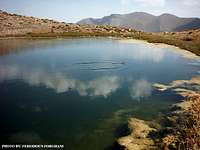-
 4291 Hits
4291 Hits
-
 78.27% Score
78.27% Score
-
 9 Votes
9 Votes
|
|
Mountain/Rock |
|---|---|
|
|
36.63171°N / 50.52621°E |
|
|
Hiking, Mountaineering |
|
|
Summer |
|
|
11450 ft / 3490 m |
|
|
Overview
Introduction to Central Alborz Mountains
Mt Boloor (Crystal mountain) is a very special peak because of its prominent religious position in the locals' beliefs. There is a Holy Shrine on the summit of this peak which has hundreds of pilgrims each year on spring and summer. Seeing an old lady getting to the summit riding a mule is a common thing to see in Mt Boloor when it's the time.
The name Boloor comes from the white color of this mountain which makes it shine between all its surrounding mountains. The whole body of Mt Boloor is made of white stones while all the other mountains in the area from Mt Khashechal to the smallest peaks have a dark or yellowish look.
The Presence of the shrine on the summit has such a huge effect that many people going to Mt Boloor are known as the pilgrims of Shah-e-Sefid Kooh which means king of the white mountain.
Mt Boloor has its own legends and stories too. The story of two goats visiting the shrine frequently on special times is the most famous of these. And there are some others too.
There is also a small hut a few meters from the summit shrine known as Shah-e-Sefid Kooh Mosque. Pilgrims in summer and mountaineers in winter use this roomlike mosque.
There is almost always a severe wind on this summit. This doesn't let the snow ever to cover the summit, so the shrine is seen from far places which helps the legends grow.
While getting to the top either from south or north, there are 7 tiny masses of rock as symbols of satan which pilgrims throw stones to them before reaching the shrine.
Location
Mt Boloor is located on the eastern slopes of Eshkevar great valley. Today it take less than 5 hours to get to the summit from Mij at the end of the road. The road goes so close to the mountain so there is not much to hike anymore. This makes Eshkevar route less amazing if you are not going to climb Mt Boloor as a pilgrim.
The eastern slopes of Mt boloor fall into Miandasht valley(west-east direction), Miandasht valley meets Siagowdarreh Valley(north-south direction) and fallowing the trails from here take you to the peaceful village of Lakterashan as the last village in the great valley of Jannat Rudbar.
The north view from the summit goes far to the Caspian sea if there are no clouds in the sky(this rarely happens).
On the south you can see Mt Khashechal and its huge northern walls with its ridgeline going to east until getting to Mt siyalan.
Getting There
You should get to Tonekabon from Tehran and then drive towrd Ramsar. After about 15 Kilometers passed You should turn left to Haris road(Jaddeh Haris). After passing all the villages of Jannat Rudbar Valley you should get to The village of Lega. Afew more turns to go and then you should start hiking to Lakterashan village. You have more than an hour to drive on a dirt road which gets worth the higher you go.
If you want to climb Mt Boloor from Eshkevar then you should continue to Ramsar, Chaboksar, Kelachay, RahimAbad and then drive to the end of Eshkever road from Rahim Abad.
Red tape
There are no red tapes.
Summit Views
Camping
Plenty of great places for camping specially on Siagowdarreh route. It's also possible to stay in the Sheperd houses. Very lovely people.










